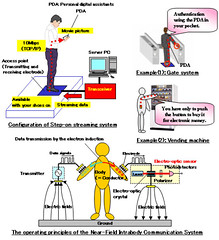Your Mobile Phone & Your Money
If you’re as absent minded as me, you’ve probably left home once or twice without your wallet, but with your mobile phone attached to your hip. Well, in the future forgetting your wallet may not matter so much as long as you have your mobile phone, at least where needing cash on hand is concerned. Your mobile phone may serve as your wallet.
By next year, you’ll be able to pay simply by swiping your cell phone a few inches from a cash register, with a new wireless standard called Near Field Communication.
An NFC chip in your phone will send your credit-card number — stored on your phone or on the chip — by way of short-distance radio waves.
An electronic reader at the checkout will decode the number and ring up your purchase. Unlike radio-frequency identification (RFID) and other existing contactless payment systems, NFC chips allow two-way information exchange by rolling an RF transmitter and reader into one five-millimeter package.
That means the chip can also take in data, such as a receipt zapped to it by a cash register or a bus schedule from a tag embedded in a bus-stop sign.
What’s Near Field Communications? Glad you asked. (And if you didn’t, I did.) This definition includes a handy chart.
But the NFC Forum has the easiest explanation I’ve found.
Near Field Communication (NFC) uses the same principle to link electronic devices. It enables the user to exchange all kinds of information, securely, simply by bringing two devices close together. Its short-range interaction over a few centimeters greatly simplifies the whole issue of identification, as there is less confusion when devices can only "hear" their immediate neighbors.
Evolving from a combination of contactless identification (RFID) and interconnection technologies, NFC technology bridges today’s connectivity gap. It enables the simple transfer of information — from phone numbers to electronic transactions — and allows people to interact with their environment without needing to navigate complicated menus or perform complex set-up procedures.
I wasn’t sure sure what makes that any different than Bluetooth or wi-fi, but apparently it’s a matter of range.
While Bluetooth and Wi-Fi have a range anywhere between 33 feet and 300 feet, NFC deals in inches — eight inches, to be precise. NFC "is designed for shorter distances and lighter content," says Karsten Ottenberg, General Manager of Philips Semiconductors’ Identification unit.
Great. There are only two drawbacks I can think of, and one of them has already been shot down. First, I thought I’d have to buy a new phone, but it turns out simple add-on chips will be available and that they’re pretty inexpensive to produce. That just leaves one problem. Would losing your phone become the same as losing your wallet?
